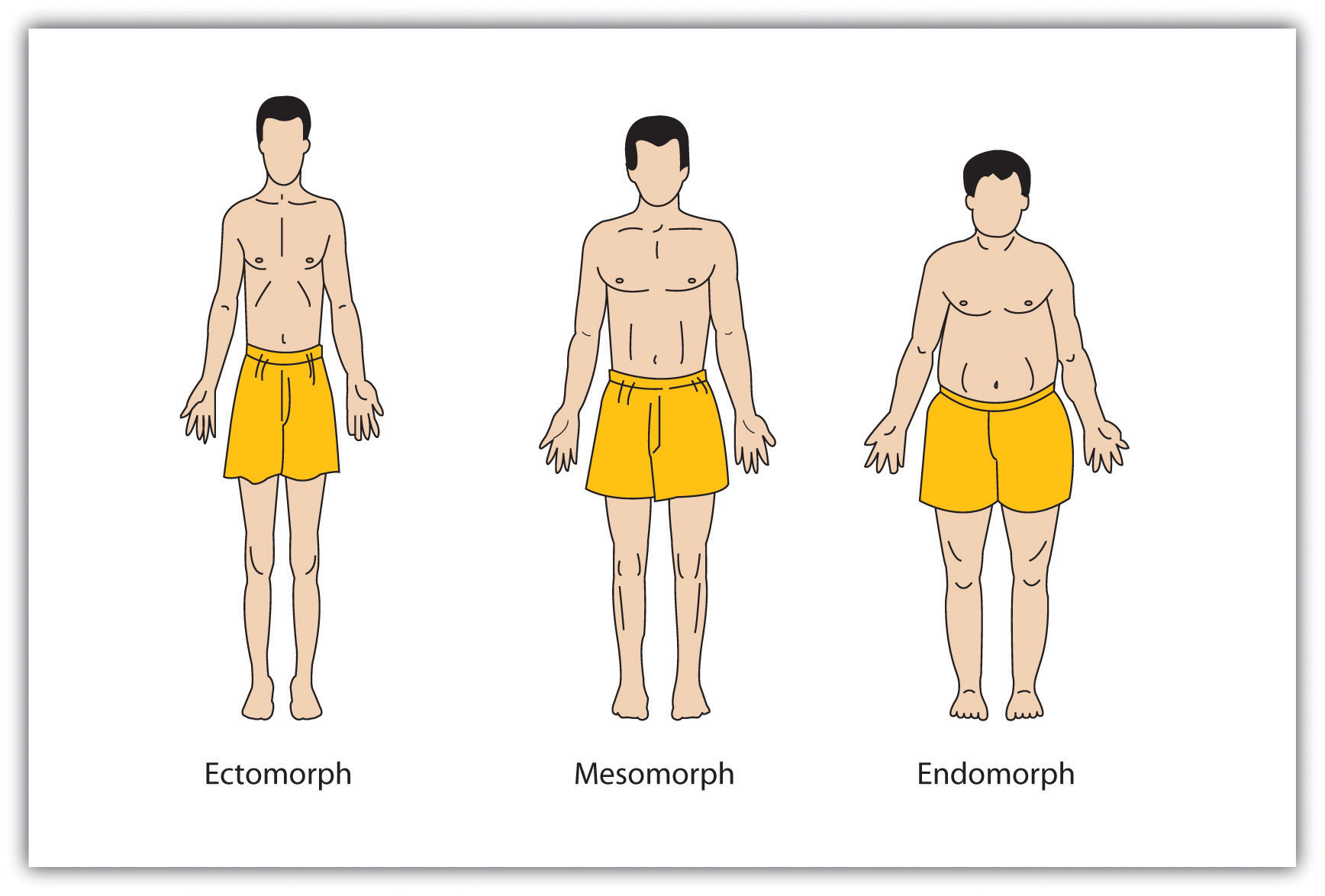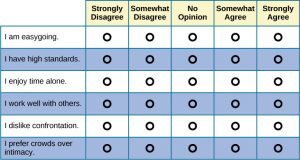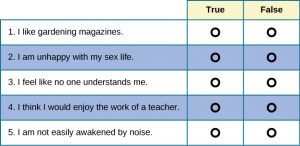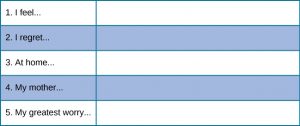14.1 Personality Measurement
Learning Objectives
- Outline and critique the early approaches to assessing personality.
- Discuss the Minnesota Multiphasic Personality Inventory.
- Recognize and describe common projective tests used in personality assessment.
Early theories assumed that personality was expressed in people’s physical appearance. One early approach, developed by the German physician Franz Joseph Gall (1758–1828) and known as phrenology, was based on the idea that we could measure personality by assessing the patterns of bumps on people’s skulls (see Figure 14.1). In the Victorian age, phrenology was taken seriously, and many people promoted its use as a source of psychological insight and self-knowledge. Machines were even developed for helping people analyze skulls (Simpson, 2005). However, because careful scientific research did not validate the predictions of the theory, phrenology has now been discredited in contemporary psychology.

Another approach, known as somatology, championed by the psychologist William Herbert Sheldon (1898–1977), was based on the idea that we could determine personality from people’s body types (see Figure 14.2). Sheldon (1940) argued that people with more body fat and a rounder physique (i.e., endomorphs) were more likely to be assertive and bold, whereas thinner people (i.e., ectomorphs) were more likely to be introverted and intellectual. As with phrenology, scientific research did not validate the predictions of the theory, and somatology has now been discredited in contemporary psychology.

Another approach to detecting personality is known as physiognomy, or the idea that it is possible to assess personality from facial characteristics. In contrast to phrenology and somatology, for which no research support has been found, contemporary research has found that people are able to detect some aspects of a person’s character — for instance, whether they are gay or straight and whether they are liberal or conservative — at above-chance levels by looking only at their face (Rule & Ambady, 2010; Rule, Ambady, Adams, & Macrae, 2008; Rule, Ambady, & Hallett, 2009).
Personality testing is often used to screen applicants for employment and job training. Personality tests are also used in criminal cases, custody battles, and assessments of psychological disorders. This section explores the best known among the many different types of personality tests.
Self-report inventories
Self-report inventories are a kind of objective test used to assess personality. They typically use multiple-choice items or numbered scales, which represent a range from 1, signalling strong disagreement, to 5, identifying strong agreement (see Figure 14.3). They often are called Likert scales after their developer, Rensis Likert (1932).

One of the most widely used personality inventories is the Minnesota Multiphasic Personality Inventory (MMPI), first published in 1943, with 504 true-false questions, and updated to the MMPI-2 in 1989, with 567 questions. The original MMPI was based on a small, limited sample, composed mostly of Minnesota farmers and psychiatric patients; the revised inventory was based on a more representative, national sample to allow for better standardization. The MMPI-2 takes one to two hours to complete. Responses are scored to produce a clinical profile composed of 10 scales: hypochondriasis, depression, hysteria, psychopathic deviance (i.e., social deviance), masculinity versus femininity, paranoia, psychasthenia (i.e., obsessive-compulsive qualities), schizophrenia, hypomania, and social introversion. There is also a scale to ascertain risk factors for alcohol abuse. In 2008, the test was again revised, using more advanced methods, to the MMPI-2-RF. This version takes about one-half the time to complete and has only 338 questions (see Figure 14.4). Despite the new test’s advantages, the MMPI-2 is more established and is still more widely used. Typically, the tests are administered by computer. Although the MMPI was originally developed to assist in the clinical diagnosis of psychological disorders, it is now also used for occupational screening, such as in law enforcement, and in college, career, and marital counselling (Ben-Porath & Tellegen, 2008).

In addition to clinical scales, the tests also have validity and reliability scales. Recall the concepts of reliability and validity from your study of psychological research. One of the validity scales, the Lie Scale, or “L” Scale, consists of 15 items and is used to ascertain whether the respondent is “faking good” (i.e., underreporting psychological problems to appear healthier). For example, if someone responds “yes” to a number of unrealistically positive items such as “I have never told a lie,” they may be trying to “fake good” or appear better than they actually are.
Reliability scales test an instrument’s consistency over time, assuring that if you take the MMPI-2-RF today and then again five years later, your two scores will be similar. Larry Beutler, Paul Nussbaum, and Keith Meredith (1988) gave the MMPI to newly recruited police officers and then to the same police officers two years later. After two years on the job, police officers’ responses indicated an increased vulnerability to alcoholism, somatic symptoms (i.e., vague, unexplained physical complaints), and anxiety. When the test was given an additional two years later — four years after starting on the job — the results suggested high risk for alcohol-related difficulties.
Projective tests
Another method for assessment of personality is projective testing, which relies on one of the defence mechanisms proposed by Sigmund Freud — projection — as a way to assess unconscious processes. During this type of testing, a series of ambiguous cards is shown to the person being tested, who then is encouraged to project their feelings, impulses, and desires onto the cards — by telling a story, interpreting an image, or completing a sentence. The results are then interpreted by the test administrator. Many projective tests have undergone standardization procedures (e.g., Exner, 2002) and can be used to access whether someone has unusual thoughts, a high level of anxiety, or is likely to become volatile. Some examples of projective tests are the Rorschach Inkblot Test, the Thematic Apperception Test (TAT), the Contemporized-Themes Concerning Blacks Test (C-TCB), the TEMAS (Tell-Me-A-Story), and the Rotter Incomplete Sentences Blank (RISB).
The Rorschach Inkblot Test was developed in 1921 by a Swiss psychologist named Hermann Rorschach (pronounced “ROAR-shock”). It is a series of symmetrical inkblot cards that are presented to a client by a psychologist (see Figure 14.5). Upon presentation of each card, the psychologist asks the client, “What might this be?” What the test-taker sees reveals unconscious feelings and struggles (Piotrowski, 1987; Weiner, 2003). The Rorschach has been standardized using the Exner system and is effective in measuring depression, psychosis, and anxiety.

A second projective test is the Thematic Apperception Test (TAT), created in the 1930s by Henry Murray, an American psychologist, and a psychoanalyst named Christiana Morgan. A person taking the TAT is shown eight to 12 ambiguous pictures and is asked to tell a story about each picture. The stories give insight into their social world, revealing hopes, fears, interests, and goals. The storytelling format helps to lower a person’s resistance divulging unconscious personal details (Cramer, 2004). The TAT has been used in clinical settings to evaluate psychological disorders; more recently, it has been used in counselling settings to help clients gain a better understanding of themselves and achieve personal growth. Standardization of test administration is virtually nonexistent among clinicians, and the test tends to be modest to low on validity and reliability (Aronow, Weiss, & Rezinkoff, 2001; Lilienfeld, Wood, & Garb, 2000). Despite these shortcomings, the TAT has been one of the most widely used projective tests.
A third projective test is the Rotter Incomplete Sentences Blank (RISB) developed by Julian Rotter in 1950. There are three forms of this test for use with different age groups: the school form, the college form, and the adult form. The tests include 40 incomplete sentences that people are asked to complete as quickly as possible (see Figure 14.6). The average time for completing the test is approximately 20 minutes, as responses are only one to two words in length. This test is similar to a word association test, and like other types of projective tests, it is presumed that responses will reveal desires, fears, and struggles. The RISB is used in screening college students for adjustment problems and in career counselling (Holaday, Smith, & Sherry, 2010; Rotter & Rafferty 1950).

For many decades, these traditional projective tests have been used in cross-cultural personality assessments. However, it was found that test bias limited their usefulness (Hoy-Watkins & Jenkins-Moore, 2008). It is difficult to assess the personalities and lifestyles of members of widely divergent ethnocultural groups using personality instruments based on data from a single culture or race (Hoy-Watkins & Jenkins-Moore, 2008). For example, when the TAT was used with African-American test-takers, the result was often shorter story length and low levels of cultural identification (Duzant, 2005). Therefore, it was vital to develop other personality assessments that explored factors such as race, language, and level of acculturation (Hoy-Watkins & Jenkins-Moore, 2008). To address this need, Robert Williams developed the first culturally specific projective test designed to reflect the everyday life experiences of African Americans (Hoy-Watkins & Jenkins-Moore, 2008). The updated version of the instrument is the Contemporized-Themes Concerning Blacks Test (C-TCB), which contains 20 colour images that show scenes of African-American lifestyles (Williams, 1972). When the C-TCB was compared with the TAT for African Americans, it was found that use of the C-TCB led to increased story length, higher degrees of positive feelings, and stronger identification with the C-TCB (Hoy, 1997; Hoy-Watkins & Jenkins-Moore, 2008).
Despite their widespread use, the empirical evidence supporting the use of projective tests is mixed (Karon, 2000; Wood, Nezworski, Lilienfeld, & Garb, 2003). The reliability of the measures is low because people often produce very different responses on different occasions. The construct validity of the measures is also suspect because there are very few consistent associations between Rorschach scores or TAT scores and most personality traits. The projective tests often fail to distinguish between people with psychological disorders and those without, and they often fail to correlate with other measures of personality or with behaviour. As such, projective tests are more useful as icebreakers to get to know a person better, to make the person feel comfortable, and to get some ideas about topics that may be of importance to that person rather than for accurately diagnosing personality.
In the next section we will view the most popular model of trait personality theory, which is the idea that personality is structured by a fundamental number of traits. In contrast to the projective testing discussed above, trait models tend to employ objective, standardized tests that have shown to be reliable and valid. Standardized tests do not rely on the text administrator’s interpretation of the test-taker’s responses, and norms obtained through research are used to provide scores.
Source: Adapted from Spielman et al. (2019).
Key Takeaways
- Personality is an individual’s consistent patterns of feeling, thinking, and behaving.
- Early theories assumed that personality was expressed in people’s physical appearance. One of these approaches, known as physiognomy, has been validated by current research.
- Self-report personality tests like the MMPI are used to assess personality, screen applicants for job training, in criminal cases, and in custody battles.
- Projective tests are based on the assumption that the test-taker will project unconscious aspects of their personality onto their test responses. Many projective tests lack reliability and validity.
Image Attributions
Figure 14.1. 1895-Dictionary-Phrenolog by unknown author is in the public domain.
Figure 14.2. Used under a CC BY-NC-SA 4.0 license.
Figure 14.3. Used under a CC BY 4.0 license.
Figure 14.4. Used under a CC BY 4.0 license.
Figure 14.5. Rorschach Blot 02 by Hermann Rorschach is in the public domain; Rorschach Blot 08 by Hermann Rorschach is in the public domain; Rorschach Blot 09 by Hermann Rorschach is in the public domain; Rorschach Blot 10 by Hermann Rorschach is in the public domain.
Figure 14.6. Used under a CC BY 4.0 license.
Long Description
Figure 14.1. Phrenology can be defined as follows:
- Science of the special functions of the several parts of the brain or of the supposed connection between the faculties of the mind and organs of the brain.
- Physiological hypothesis that mental faculties, and traits of character, are shown on the surface of the head or skull; craniology.
References
Aronow, E., Weiss, K. A., & Rezinkoff, M. (2001). A practical guide to the Thematic Apperception Test. Philadelphia, PA: Brunner-Routledge.
Ben-Porath, Y., & Tellegen, A. (2008). Minnesota Multiphasic Personality Inventory-2-RF. Minneapolis: University of Minnesota Press.
Beutler, L. E., Nussbaum, P. D., & Meredith, K. E. (1988). Changing personality patterns of police officers. Professional Psychology: Research and Practice, 19(5), 503–507.
Cramer, P. (2004). Storytelling, narrative, and the Thematic Apperception test. New York, NY: Guilford Press.
Duzant, R. (2005). Differences of emotional tone and story length of African American respondents when administered the Contemporized Themes Concerning Blacks Test versus the Thematic Apperception Test. Unpublished doctoral dissertation, The Chicago School of Professional Psychology, Chicago, IL.
Exner, J. E. (2002). The Rorschach: Basic foundations and principles of interpretation (Vol. 1). Hoboken, NJ: Wiley.
Holaday, D., Smith, D. A., & Sherry, A. (2010). Sentence completion tests: A review of the literature and results of a survey of members of the society for personality assessment. Journal of Personality Assessment, 74(3), 371–383.
Hoy, M. (1997). Contemporizing of the Themes Concerning Blacks Test (C-TCB). Alameda, CA: California School of Professional Psychology.
Hoy-Watkins, M., & Jenkins-Moore, V. (2008). The Contemporized-Themes Concerning Blacks Test (C-TCB). In S. R. Jenkins (Ed.), A handbook of clinical scoring systems for thematic apperceptive techniques (pp. 659–698). Mahwah, NJ: Lawrence Erlbaum.
Karon, B. P. (2000). The clinical interpretation of the Thematic Apperception Test, Rorschach, and other clinical data: A reexamination of statistical versus clinical prediction. Professional Psychology: Research and Practice, 31(2), 230–233.
Likert, R. (1932). A technique for the measurement of attitudes. Archives of Psychology, 140, 1–55.
Lilienfeld, S. O., Wood, J. M., & Garb, H. N. (2000). The scientific status of projective techniques. Psychological Science in the Public Interest, 1(2), 27–66.
Piotrowski, Z. A. (1987). Perceptanalysis: The Rorschach method fundamentally reworked, expanded and systematized. London, UK: Routledge.
Rotter, J. B., & Rafferty, J. E. (1950). Manual, the Rotter Incomplete Sentences Blank: College form. New York, NY: The Psychological Corporation.
Rule, N. O., & Ambady, N. (2010). Democrats and Republicans can be differentiated from their faces. PLoS ONE, 5(1), e8733.
Rule, N. O., Ambady, N., & Hallett, K. C. (2009). Female sexual orientation is perceived accurately, rapidly, and automatically from the face and its features. Journal of Experimental Social Psychology, 45(6), 1245–1251.
Rule, N. O., Ambady, N., Adams, R. B., Jr., & Macrae, C. N. (2008). Accuracy and awareness in the perception and categorization of male sexual orientation. Journal of Personality and Social Psychology, 95(5), 1019–1028.
Sheldon, W. (1940). The varieties of human physique: An introduction to constitutional psychology. New York, NY: Harper.
Simpson, D. (2005). Phrenology and the neurosciences: Contributions of F. J. Gall and J. G. Spurzheim. ANZ Journal of Surgery, 75(6), 475–482.
Spielman, R., Dumper, K., Jenkins, W., Lacombe, A., Lovett, M., & Perlmutter, M. (2019). Personality. In OpenStax, Psychology. OpenStax CNX. Retrieved from https://cnx.org/contents/Sr8Ev5Og@10.16:X7lIv6fX@10
Weiner, I. B. (2003). Principles of Rorschach interpretation (2nd ed.). Mahwah, NJ: Lawrence Erlbaum.
Williams, R. L. (1972). Themes concerning blacks: Manual. St. Louis, MO: Williams.
Wood, J. M., Nezworski, M. T., Lilienfeld, S. O., & Garb, H. N. (2003). What’s wrong with the Rorschach? Science confronts the controversial inkblot test. San Francisco, CA: Jossey-Bass.

